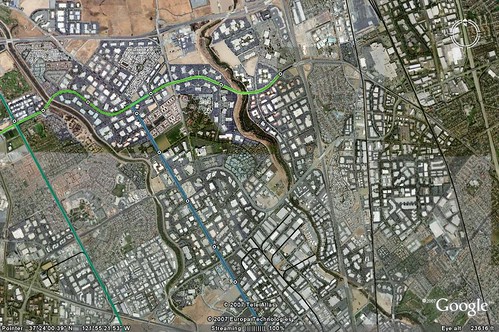Saturday, December 29, 2007
Sprinter Line Opens for Press
News Coverage of the event...
LA Times
AP
San Diego Union Tribune
Friday, December 28, 2007
Streetcars Sell ... Products

Thursday, December 27, 2007
Hampton Roads News
Virginia Beach wants a $15 million grant from the Virginia Department of Transportation to help pay for the rail line that runs between Newtown and Birdneck roads if an agreement to sell it is ever reached.
The track is owned by Norfolk Southern Corp. and is considered the logical extension of Norfolk’s light rail project, which began construction this month with utility work at Harbor Park.
Tuesday, December 25, 2007
Ashmont Mattapan Christmas Update
Monday, December 24, 2007
Further Expansion Considered in NC
Saturday, December 22, 2007
Amtrak Sees Ridership Rise
Friday, December 21, 2007
A Year of The Overhead Wire
Thursday, December 20, 2007
Metro Dreams
Wednesday, December 19, 2007
Budapest BKV Unloading Old Trams

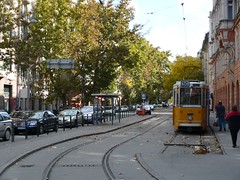

Tuesday, December 18, 2007
Photo Flashback

When I was at the Bellview Station in Denver a few months ago I snapped this photo. Would have been cool if I got an LRV to shadow the sun...perhaps next time. Also, Richard Layman mentioned the Siemens Combino Ultra in a recent post about streetcar vehicles. Here is a photo you all have probably already seen of the Combino Supra in Budapest I took while I was there in October.
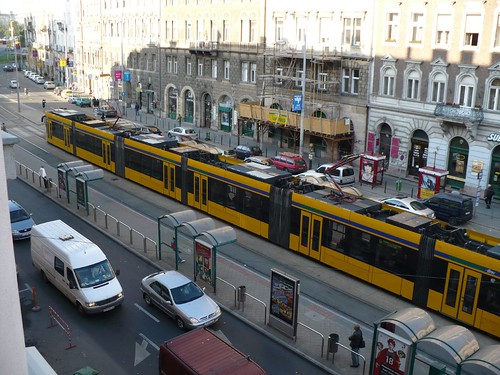
Monday, December 17, 2007
High Ridership = Rail Bias
So after a year's worth of ridership data, Charlotte planners will be able to use the bias that they weren't able to use on the first line, which if the FTA used current regulations, wouldn't even have been built. Charlotte got a medium low on their cost effectiveness rating, which now the FTA says you must have a medium to even get into Preliminary Engineering. But guess what they use to calculate cost effectiveness? Ridership! Which seems to be behind recently; Houston, Minneapolis, St. Louis, and Denver have all opened lines recently and have had much higher ridership than predicted. So higher numbers lead to better CE measures, but new lines aren't allowed the bias. Does this mean that new lines aren't afforded the right numbers? Ask the folks in Columbus Ohio. Early indications say that ridership in Charlotte will be exceeded. 9,000 riders were expected and so far daily numbers have been around 12,000. I expect it will die down a little but as more development on the South Corridor comes online, more ridership will be added. What this tells me is that more cities are going to get the short end of the New Starts stick. Is anyone else ready for a new administration that cares about urban issues?
Sunday, December 16, 2007
Moving from Colors to Numbers
Saturday, December 15, 2007
Lake Oswego Rapid Streetcar Steps Toward Reality
This would be the first modern application of the Rapid Streetcar idea. It would connect to the City of Lake Oswego to the South Waterfront Streetcar while using the same vehicles.
Thursday, December 13, 2007
Miami Surprise + Subway Rangers
Also, there was an article in the New York Times on how the Rangers take the subway to work while the Knicks park their cars wherever they want. Streetsblog has the coverage in the link above.
Wednesday, December 12, 2007
Two Seattle News Items
South Lake Union Streetcar Opens
Seattle Transit Blog
Orphan Road Overlords
Orphan Road Opens
New Viaduct News
Carless in Seattle
Orphan Road
Seattle Transit Blog
Tuesday, December 11, 2007
Transit & Acupuncture
So now I had to get to the acupuncturist in Montclaire. I left an hour before the appointment as the 59 comes every hour from Lake Merritt BART. I sat in the back of a 30 foot VanHool bus and watched the really nice houses pass by on the hills. It was actually a nice ride if not a little bumpy. But there was a catch. My appointment was going to be over at 5 but the last 59 went to the Rockridge BART at 4:15 or so. Not good. So I had to figure out a way back. Well where the 59 dropped off the 18 picked up and I was lucky enough that it ran every 15 minutes into the evening. So when I was done at 5 I hopped on the 18 and traveled on the other side of the hill from the 59. It took me to the 12th Street BART station and I hopped on the 24th street and mission turn around train to go home since I wouldn't be going to my Gramma's house.
I was thinking a bit negatively that there wasn't a 59 but my roommate pointed out that we are lucky to live in a fairly transit friendly place in the bay area and the fact that there was an 18 at all was good. It was still at 15 minute headways so yes, that was pretty good. I imagine that if I were in Houston or somewhere else this wouldn't have worked. So my car died, but i knew that I could depend on transit to get me where I needed to go. It took a little more time, but I got to watch the world go by instead of having to slog through traffic.
Monday, December 10, 2007
Sunday, December 9, 2007
Houston vs. FTA Update
The FTA's motives for withdrawing its approval after earlier approving the planned conversion to rail are unclear, but the move smacks of partisan vindictiveness. Although Little claimed in her letter that federal guidelines required the proposal to be resubmitted, Metro officials pointed out that the document's harsh tone was a striking change from previous cooperation between the agencies.
Metro's initial plan called for rail to be laid and covered on the BRT routes in preparation for an eventual shift to trains. After the FTA allowed different formulas to be used in measuring potential ridership for the lines, Metro officials decided rail construction was feasible for all the routes.
Hopefully by next November all this political jostling will be over. However I would also like to see the transit agencies stand up to the FTA and tell their congressmen they are tried of having to deal with ideology when building their transit systems. With agencies not wanting to bite the hand that feeds them, they have just let the FTA continue to push towards higher and more ridiculous standards that keeps some cities from even applying for federal funds. Perhaps this move by Metro is the first in a set of moves by the transit industry to fight back. The Chronicle editorial says it best and speaks for all transit agencies in its comments below.
Houston needs an expanded mass transit system sooner rather than later. Our elected federal officials who support that plan need to make their voices heard at the FTA to counter rail opponents and make sure backroom power plays do not delay construction.
Saturday, December 8, 2007
When Alternatives Analysis is a Wasteful Exercise
I understand doing an AA on a new corridor and in some places BRT is the best tool for the job, but forcing a study of it as an alternative when its obviously a waste of money is ridiculous. Use it to study different route alternatives instead. Besides, it looks like we are going to have to save all the money we can with the crazy inflation that is going on and the lowering of the dollar's value against other world currencies.
Gore Takes the Subway...When There is a Choice
Thursday, December 6, 2007
Proposal for a Seattle Streetcar Network

Wednesday, December 5, 2007
A Real San Francisco Metro
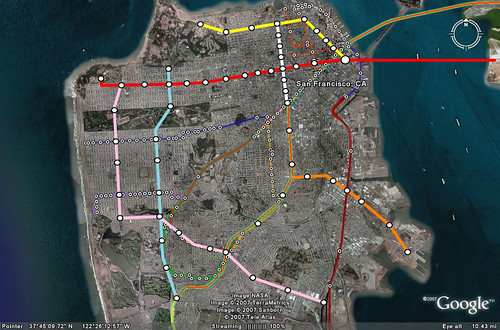
Tuesday, December 4, 2007
Those BRT Lovers at the FTA Again
These guys are ridiculous. Houston was told by the FTA that they would have to resubmit engineering forms for Preliminary Engineering now that they've gone to LRT from BRT. The annoying part is that these guys don't quit trying to water down transit. I can't wait for this administration to be gone so this crap stops happening.
But perhaps the thing that annoys me the most is that these lines were to be planned to always be LRT. In fact the EIS was supposed to have a convertible alternative in it where they would build the line and run buses on it. The FTA can't call takebacks on this as its in the New Starts Report for Houston. So they decided to change the timeline and go LRT early. It's not like the FTA didn't know they were going to do it eventually. This is a stall tactic and I'm wondering if someone named Culbertson isn't behind the details. The current congressional delegation needs to step up now and set it straight.
Sunday, December 2, 2007
An Oakland Metro
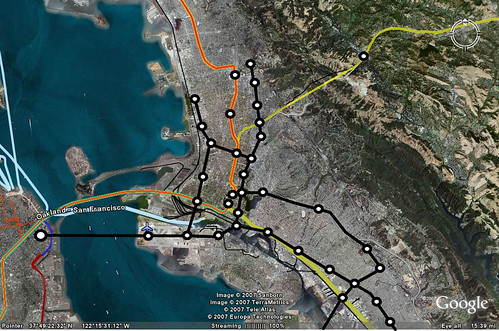
Saturday, December 1, 2007
Initial Ridership Figures for CATS
Thursday, November 29, 2007
A Real Bay Area Metro
Why do I think we should invest more in urban subway systems? Because these lines have been driving national ridership gains over the last 15 years. (data here). Heavy Rail has produced about the same gain as bus, light rail, and commuter rail combined. Obviously there are different modes for different purposes. But some corridors need a metro, more than BART has now. Perhaps we should start a campaign? The Urban Subway Expansion Project. Any other cities that should join? I nominate LA first.
So where should we put new subways? In the Bay Area.... we'll just make a map. Any corridors? I'll start with Geary haha.
Wednesday, November 28, 2007
Transit Effectiveness Project
Operating Speed: This shows where Muni is really slowed down by traffic. No Surprise that Van Ness and Stockton are some of the worst. I wish we would have had this data before the 3rd Street LRT project was started. Take a look at that street. Green. This is why data is important. It makes political decisions much easier. Now thats not to say that it won't get more congested as the are grows around light rail and it needed to become rail at some point, but there are many pressing needs in the city, mainly Van Ness and the long orange Geary.

Boardings: This shows where people board the buses. The most effective transit is on the main corridors and major traffic generators. It's interesting to note that where there is a high capacity spine, there are a lot of boardings. Most noticeable is along Mission BART. It shows how system boardings would probably improve if BART was expanded to Geary then down 19th such as proposed by SF Cityscape. It would improve boardings on the bus lines connecting to the stations.

Trips: The above observation is proven below in that there is a missing link between the Sunset and Richmond districts. The red dots are total trips between districts. Since there are a lot of trips North from the Richmond South towards SF State it would make a lot of sense to have rapid transit fed by east west buses.
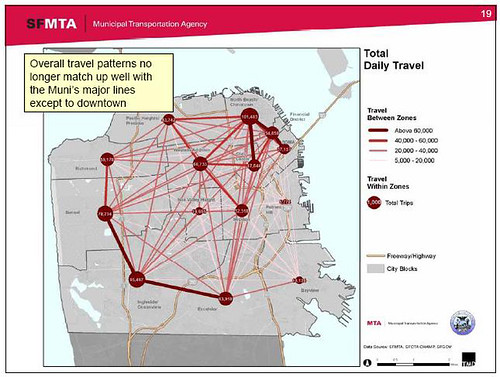
Data. It's an amazing thing. According to one AC Transit board member at tonight's TALC meeting, they will be doing this soon as well which should bring some even more interesting results.
Tuesday, November 27, 2007
New Blogs for the Roll
Jacksonville Transit - Transit News from Jacksonville Florida.
Light Rail AZ - Discussing Phoenix Light Rail Issues.
Light Rail in Grand Rapids - A Discussion of Grand Rapids Transit Progress.
Street Heat - LA Transportation News.
Monday, November 26, 2007
Austin News and Flashback
I'm just going to link to some stuff...
M1ek talks about the good and bad of CAMPO taking rail planning away from Cap Metro. Discussions about Mike Krusee (A bit of a shady character), should not be had without also noting that Lee Walker is back for 2 more years. Some locals believe he was a major part of the 2000 election loss because of some pre-election decisions to not do more outreach and the fact that he and others gave in to demands from Republicans in the state house on Commuter and Light Rail.
Here's a fun flashback from my Master's PR/Thesis.
In the 1999 legislative session, Mike Krusee, a State Representative from Round Rock, authored new legislation that would let Capital Metro keep half of its cent sales tax and let voters decide what to do with the other half. The bill died in committee due to Capital Metro’s urging because the transit authority convinced lawmakers that they would have an election in 2000 and that the voters should be able to decide the fate of rail before another raid on Capital Metro’s sales tax revenue.In more news, the Statesman claims Capital Metro needs to be clearer in its book keeping after an article by Ben Wear about costs of the new commuter rail line. It's just another attack, but they better get used to it as it's gonna keep on coming with this line.
...
As 2000 loomed as the year for the final decision, the Capital Metro board was grappling with whether to hold the election in May or November. The main concern was getting federal funding and giving the community enough time to understand the details of the light rail plan. There were even attempts to satiate the road warriors that included Gerald Daugherty’s ROAD group. Mayor Kirk Watson floated an idea of putting road bonds on the ballot along with the rail election but it was criticized once again by Daugherty as insufficient. Daugherty still wanted money from Capital Metro for road building.
...
In 2003, another interesting development occurred in rail planning. State Representative Krusee, the new chairman of the Texas House of Representatives Transportation Committee was quoted at a private transportation meeting as saying that he would like to see a commuter rail system in Central Texas. Preferably, the lines would be located on existing Capital Metro right of way as well as the Union Pacific right of way located between San Marcos and his constituency in Round Rock. Representative Krusee proposed a starter red line replacing the 1998 consultant’s green line light rail in 2000. Consultants in 1998 believed that the green line was a better route for ridership production however it was turned down by the voters in 2000. It seemed that commuter rail was on Senator Krusee’s mind even before the 2000 election. In a 2000 Austin American Statesman article, he was quoted, “I wish they would be more open-minded to alternatives to light rail”.
Jim Skaggs, Gerald Daugherty's best buddy, also penned an already debunked article also. I'll bring you a few of the debunkings soon but this gets so tiring. When can advocates go on the offensive already?
Sunday, November 25, 2007
Livermore BART Extension
Planning for this extension has been on BART's mind for but studied seriously since at least 2003. The study initially looks at just going down the I-580 Median. Boooorrrrinnnggg and cheap. From the BART study done by Nelson Nygaard below...

The study also looks at connections to Walnut Creek, but we're going to focus on the Pleasanton area extension. Also, BART is building an infill station at Dublin. It's represented below as a black and white dot. The blue line is the Dublin/Pleasanton BART line which goes to SFO. The green line is the ACE commuter rail that goes to the Central Valley. This was also the route for the Altamont high speed rail alignment I believe.
But here are possible alignments. The yellow line is my favorite. It goes through the dense neighborhood being created to the north (orange box) and moves along vacant land that could be zoned for dense office and residential. It also passes the Livermore Airport, downtown livermore and gets right next to the Livermore National Labs facility which the north side of the station area could provide park and ride facilities for those driving over the Altamont who didn't use the ACE Train.
The red line uses the freeway until it gets to a crossover point. The cross over point allows the transit to move onto the ACE ROW and stop at stations up there. It along with the freeway median all the way out to Livermore plan are the cheap ways out. They might be cost effective but they do not provide opportunity for livable neighborhoods around the stations, since there is are 4 lanes of the freeway running on each side of the train. This will make the stations fairly auto/park n ride oriented. Also, if
Any thoughts? (The right side is cut off. Click on the picture to get a full view)
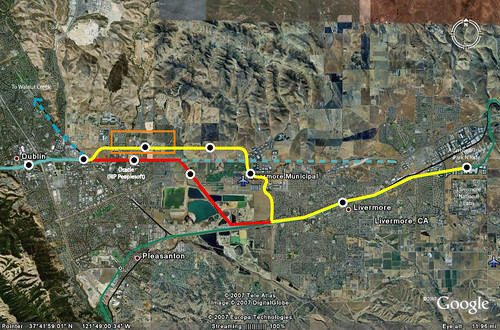
Charlotte Light Rail Open for Business
That puts our region in a select group of metropolitan areas by welcoming a critical new resource that expands local transportation options. It's a far-sighted step, one that positions this community for an increasingly urban future.It's amazing that some cities get it, and people in other cities still don't.
Saturday, November 24, 2007
Bakersfield California
There isn't a building higher than 3 stories anywhere except for perhaps one or two and those are surrounded by huge parking lots. Elevators are an obvious rarity. I'm not sure what good having high speed rail down here would be. I know that it would be good for transportation but wouldn't it just be aiding all this crap that gets built down here? I'm sure though that in a few years when water runs short and there get to be too many people, things will change, but will it catastrophic or a slow bleed? I guess we'll have to wait and see. In the mean time, I'll be here at Christmas and Thanksgiving, traveling by car, and stuck on I-5 during if there is a wreck.
Thursday, November 22, 2007
Tuesday, November 20, 2007
Denial Isn't Just a River in Africa
Jeter and Lucas said they're willing to discuss options with CATS because they're not against the train, just the funding plan.
Swain said those on her board opposed to TIF financing are "wrestling with their ideological philosophies and the mandate of the people."
Two weeks ago voters approved keeping a Mecklenburg County half-cent sales tax that funds transit projects, such as the train.
Jeter said the 70 percent support of voters for maintaining the tax wasn't a "mandate from the Huntersville residents that they want commuter rail in Huntersville."
He said the train is part of the town's future transportation solution, but that roads should come first. The town doesn't spend any of its money on road building, but it should, he said.
How soon is the future? Most have said its now. The transit opponents all said "This is a referendum on the trains". How quickly things change. My feeling is that, if they don't want it, start on the downtown streetcar. The black community in Charlotte who rallied for the transit tax and were promised a sped up streetcar construction timeline will be more willing to build now than these folks.
Monday, November 19, 2007
Second Avenue Gets FFGA from FTA
Sunday, November 18, 2007
RSS Feeds and Information Sharing
Update: There is an RSS Feed here for Progressive Railroading.
Update 2: Railway Technology has a feed here.
Progressive Railroading - News compilation organization.
Railway Age - More railroads than transit but it would be nice to get feeds on articles that are in the most recent edition
Light Rail Now! - I know a lot of folks get info from Lyndon and Dave. I've pestered them about feeds a few times as have others.
APTA Heritage Trolley - Updates news about streetcars and heritage streetcars around the country.
CFTE - Election central for transit ballot measures
Citizens for Modern Transit St. Louis - Tom Shrout and Co are doing a great job in STL.
CfPT Atlanta - Folks doing good work in Atlanta
FTA - A feed needed please
Journal of Transport and Land Use - Not publishing yet, but when they do...
LRTA - International Light Rail News
Railway Technology - Updates from around the world.
And many more. If anyone wants to send any of these folks in email asking them nicely to get an rss feed that would be awesome. I've already emailed a few with mixed results. Also, if anyone has any other sites to add let me know.
Saturday, November 17, 2007
Creating Demand for Office TOD
Demand for quality space in Google-land is strong, and market rental rates now justify the costs of redeveloping obsolete industrial structures into higher-density modern offices, observes veteran Silicon Valley commercial broker Gregory M. Davies at CPS/Corfac Intl. in Santa Clara.
Planned commercial projects are taking advantage of the neighborhood's attractive transit service, including not only the VTA light-rail system but also Caltrain's Baby Bullet express service whizzing commuters from San Francisco in well under an hour, Davies adds.
This also brings up another point about San Jose. The office park sprawl there with all the tech companies is probably the worst I've ever seen. I don't get why our buddy Randal O'Toole calls San Jose a failure in Smart Growth when there is none. The land use around light rail is the worst in the country and never focused. Just junk buildings that should be destroyed and reoriented towards the streets and given a grid.
Check out the aerial below to see what it looks like. Tons of parking spaces and wasted land. Its amazing this system gets over 30,000 riders a day. The green and blue lines are the San Jose Light Rail. Looks like its going through a bunch of industrial warehouses, but they are just single use offices.
Thursday, November 15, 2007
So What Pencils?
So when cities come up with extensive plans for the area around a light rail station that won't be there for a few years, what is a developer or city to do? The City of Aurora south of Denver is in that predicament right now. So what are citizens who want good development to do?
One way to go is to bank the land and do something that can be easily be turned when the market changes or when the rail line extension comes. Community land trusts and affordable housing funds could possibly do this or the city could buy it to hold although thats almost like the third way below. Another is to let them develop the junk they were going to, which in the case of Aurora, like Austin, is the much hated Wal-Mart. A third and sometimes unpopular way to go is to provide incentives to make the development pencil. This is what Aurora is thinking about as well.
Bob Watkins, Aurora's director of planning, said Aurora hopes the vacant plot will be developed into "a special place that would be unique and help establish an identity for the city."A big problem is figuring out where that is going to be since engineering on LRT projects and other improvements might take years. This is where developers can take issues into their own hands if they decide to help build these transit lines. Perhaps we'll start seeing more of that soon. So when a piece of land is scoped for future development, better make sure that everything people want is in order (coding, zoning, plans, affordable housing, etc) so you don't get unlucky and stuck with Wal-Mart or providing incentives.
The city is currently trying to develop an incentive package for the project.
"It probably is going to require some kind of incentive package ... I think the time is right. We have things happening with FasTracks, with RTD, everything that's going on," Hogan said.
RTD plans to extend light rail from the Nine Mile Station at Parker Road along I-225 and then swing away from the highway with a station planned at the location.
Update: Here is a map of the area. The line will take an angle and go right.
Update 2: Had the wrong line. Better picture below.

Wednesday, November 14, 2007
Electric Transit Anyone?
In the United States, the rising bill for imported petroleum lowers already anemic consumer savings rates, adds to inflation, worsens the trade deficit, undermines the dollar and makes it more difficult for the Federal Reserve to balance its competing goals of fighting inflation and sustaining growth.I've always wondered what would happen if the road builders just retooled for trolley buses and light rail and the car companies started pumping out streetcars. I know that would never happen but it would be interesting. Perhaps alternative energy competitions and innovations are in order.
Sausalito Streetcar?
Two architects in Sausalito are proposing a streetcar system to Mill Valley. According to the Marin Independent Journal:
They also have gotten the attention of elected leaders in Southern Marin, who say the trolley plan could work. Money, of course, will largely determine whether the trolley system ever becomes reality. Rex and Nichol envision a trolley that would run on tracks built into existing roads and flow with traffic. They would be powered by a single overhead electric wire.I've created a map of the route. In terms of TOD and Redevelopment, it doesn't seem like a bad one. The only problem I see is that this is a heavily traveled route by car with sections prone to auto backups. Since this is a main route, it doesn't seem wise to be in the street. There is however sufficient space in the median in many places. It also allows people who live in Mill Valley and Sausalito to get to the ferry to San Francisco fairly easily without a car and is actually close to most of the developed area. Take a look below.They figure it would cost $20 million to $50 million to get a demonstration line up and running from the Depot in Mill Valley to ferry terminal in Sausalito in five years. Trolleys would stop every quarter or half mile along Miller Avenue and then Bridgeway. Trolleys eventually could serve Novato, San Rafael, Fairfax, San Anselmo, Ross and Tiburon.
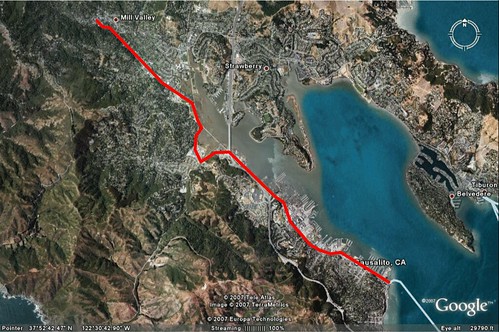
Tuesday, November 13, 2007
Updating the Transit Space Race
In the Space Race...
Wednesday Update: Updates below are in bold... Legacy Post to come soon...
Charlotte - 1 LRT Line Under Construction, 2 LRT Planned, 2 Streetcar Lines, 1 Commuter Rail Line
Dallas/Fort Worth - 2 LRT Lines, 1 Commuter Rail Line, 1 Streetcar Line, 2 LRT Lines Planned, 1 Commuter Rail line planned - More regional commuter rail discussions.
Denver - 2 LRT Lines, 2 Planned, 4 Commuter Rail Lines Planned, Streetcar discussions
Houston - 1 LRT Lines, 5 Planned, Commuter Rail discussions
Los Angeles - 1 Heavy Rail Line, 3 LRT Lines, 2 LRT Under Construction, 2 LRT Planned, 1 Heavy Rail Line Planned, 1 BRT Line, 7 Commuter Rail lines, Other Corridor Discussions
Phoenix - 1 LRT Line Under Construction, 4 Corridors Planned, Commuter rail discussion
Portland - 3 LRT Lines, 1 Streetcar Line, 1 Light Rail Line Under Construction, 1 Commuter Rail Line Under Construction, 1 Light Rail Line Planned, Streetcar Loop Planned, Streetcar Network Discussion
Salt Lake City - 2 LRT Lines, 1 Commuter Rail Line Under Construction, 4 Light Rail Lines Planned, 1 Commuter Rail Line Planned, Planned Streetcar
St. Louis - 2 LRT Lines, 2 Corridors Under Planning, Planned Streetcar
Minneapolis - 1 LRT Line, 1 Commuter Rail Line Under Construction, 3 Planned LRT Lines, Planned Streetcar System, Planned Commute Rail Lines
Transit Space Race Hopefuls...
Kansas City - Light Rail Discussion
Norfolk - 1 LRT Under Construction, Planned Network
Sacramento - 3 LRT Lines, 2 Light Rail Lines Planned, 1 Streetcar Line Planned
Seattle - 2 Streetcar Lines, 2 Commuter Rail Lines, 1 LRT Line Under Construction, Extension Planned, Commuter Rail Discussions, LRT Extension Discussions
Tampa - Regional Network discussion
Atlanta - Heavy Rail Lines, 2 Planned Streetcars, Commuter Rail Line Discussions
Eugene - 1 BRT Line, 2 Planned
San Diego - 3 Light Rail lines, 1 commuter rail line, 1 LRT line planned, Streetcar planned, BRT discussions.
Transit Space Race Hopeless...
Columbus - Streetcar Plans
Cincinnati - Streetcar Plans
Austin - Commuter Rail Under Construction, Fixed Guideway Discussions
Madison - Commuter Rail/BRT Discussions
Milwaukee - Commuter Rail/Streetcar Discussions
Orlando- Planned Commuter Rail/Network Discussions
Las Vegas - Monorail/Bus Rapid Transit
Albuquerque - Commuter Rail line, Planned Streetcar Line
Raleigh Durham - Fixed Guideway Discussion
Monday, November 12, 2007
Double Speak Means 'I Don't Like Transit'
What is interesting about this is that the anti-transit(ATs) are always asking transit to pay for itself. So when officials get innovative in their financing plan to actually have transit pay for at least a part of itself, the ATs see a threat. They don't want the train at all. The argument, 'transit should pay for itself' is actually code for 'I don't like transit'.The current financing plan for the commuter line calls for CATS to pay for 34 percent of the construction cost with the state paying for 25 percent. Just under 10 percent is already allocated for the Gateway Station project, which would be the line's signature station uptown and will be the city's Amtrak station.
The balance -- $70 million -- would come from the municipalities.
CATS wants to build the line now so it can help shape development along the train stations. It wants to create high-density housing, along with retail, near the stops. It then wants to use a portion of the property taxes generated from the high-density development to help pay for construction, called tax-increment financing.
Given that the city's part of the funding will come from new development like it did when streetcar lines were building Boston and other cities many years ago, its a surprise to me that this set of folks, who love free markets, would be against it. So the balance of $70 million would be funded through new dense development which will drive ridership AND pay some of the construction cost. Less cars on the road at rush hour and the ability to put the density away from existing neighborhoods? Sign an AT up for opposition!
I understand the worries about the market at the moment, but these things go in cycles and certain markets take off when others tank. Mixed use doesn't need to be vertical and most of the development will need to happen in phases. But they'll never get the densities around transit if they don't build the line. Meaning more people on the road and more junk multi-family apartment complexes in random places. But ATs like that kinda stuff. It's the American Dream, right?
Sunday, November 11, 2007
Team Player of the Year
Reed Connor of the Woodlands High (My high school's arch-rival) in Texas won my respect this weekend. He was in 5th place going into the last 100 meters at the Texas State Cross Country Meet for big schools when he collapsed from dehydration. He got up and wobbled the final 25 meters and finished 5th on his team to beat Southlake Carroll by 6 points. This is one of the gutsiest moves I've ever seen. He was later taken to the hospital and given 4 liters of fluid by IV and is in good condition.
If you want to see the video of this amazing feat, check out FloTrack and watch the 5A boys finish.
What is also amazing is that since 1981, Kingwood (my high school) and the Woodlands have won the State XC meet 22 out of the last 25 years. That's a pretty good dynasty for both teams.
I also want to give a shout out to the Lady Mustangs at Kingwood High for winning their 7th State Championship.
Making Connections to the Airport
If the city is building its first light rail line, I'm not sure a move to the airport alone is the best decision for a city to make. While its good to connect the airport to downtown for travelers, they don't make up a big enough share of transit users to justify a first line. The first line, as has been said a lot lately, should be a starter line that will get the highest ridership and connect the most destinations. Extensions can move to the airport and some airports might even be willing to build or pay for that connection such as TIA in Tampa.
In Sacramento, there is a discussion going on as to whether the DNA line should extend all the way to the airport. This is covered with good points by RT Rider. The line is going to go to Nantomas and I don't see a reason why at some point the line shouldn't be extended to the airport. Because so many people go to Sacramento to the state capitol, it would seem to me that there would be a lot more trips than general generated from the airport and would make the city a bit more competitive for jobs and growth.
In Dallas, some locals are upset that the new light rail line didn't get a tunnel to love field which it will pass along its alignment. It is silly for the federal government to base this decision on cost alone (cost effectiveness strikes again) because as Richard Layman discusses, there are much more external benefits that aren't counted in a traditional cost benefit ratio usually touted by the Reason foundation and the anti-transit faction who of course don't use that same measure for roads. But now, Dallas is looking to tax flights to pay for a people mover to connect the airport and light rail station in a subway.
Austin's Mayor and a council member have opened discussions recently to build light rail to the airport. If that line goes through Riverside and up Guadalupe, it would be a good extension, and could possibly spur TOD along Riverside towards the Airport. But perhaps a phase II scheme would be best.
Some here in San Francisco argue that BART to SFO should have never been built but rather Caltrain should have been electrified and a people mover connect the station to the airport. Obviously for me its easier with BART to the airport to get there because instead of a one seat ride I'd have a three seat ride. Obviously I like it, but it benefits me directly.
So what does this mean? Is it important to connect to the airport? Depends on who you ask. Personally, I think that an airport connection by rail is a sign that the city is moving in the right direction. It should be the goal of cities to make it easier for travelers to get places they visit without cars while also making it painless to get to the airport sans traffic jam. But the regional benefits and connections should be taken into account as well.
Saturday, November 10, 2007
Yes, Thank You San Francisco
Thursday, November 8, 2007
Watch that Wedge Jacking Up the Freeway
The reason I bring this up is that the head of the NRDC came and spoke at Rail~Volution and mentioned that BRT as a mode was better for the environment than light rail from an energy standpoint. WHAT? I could feel the collective annoyance of the audience when he said this. This is the same point that the anti-rail crowd has been trying to jam down people's throats, the idea that because of coal fired power plants light rail is dirty. Well we know this is BS, (proven here too) but it also misses the point. Transit is a part of the solution but so is its integration with and promotion of land use and other modes such as bikes and walking. Buses just serve existing land use but do not change the paradigm along the high capacity spine of a transit network. (Note that I don't believe light rail is best for every situation and bus networks are important feeders). When you add this paradigm shift in, the decision to invest in rail transit creates drastic reductions in emissions.
Everyone should see CNT's map of Chicago CO2 gases per capita. It shows that where there is good transit and good land use, reductions in emissions occur on a per capita basis. This is due to the fact that when you give people options, they don't drive as much reducing GHGs. They might bike or walk and these modes also need infrastructure improvements also to complete the modal network effect. This is why the whole argument that electric cars are going to solve everything drives me crazy. Even with electric cars you get the same wasteful land use patterns which are incredibly energy intensive.
So while consultants to the Sierra Club and NRDC get it, there are still too many people in those organizations and in congress focusing mostly on technology for automobiles and BRT without dealing with the combination of two things that create the most efficient reductions in GHGs, buildings and transport. There are some that are starting to get it. But in order to do it, we need to change our infrastructure priorities to modes which promote the change, not just serve it. Don't get me wrong, buses are necessary, but don't tell me that BRT as a single mode is better than light rail for GHG emission reductions.
But now after the Seattle election we have an even bigger problem. The people in the roads faction know that the enviros split the vote and are going to exploit it. Already there have been articles touting the separation between the light rail supporters and the environmental community however wrong their assessments are on why there was a separation. The CSM article pushes the meme that the enviros were divided because of the transit portion, and not because of all the roads that caused problems. It seems that we have a breach in the wall and need to fill it.
S0 the environmental community in Seattle might have just created a new talking point for the opposition. So even if there aren't any GHG generating roads in new elections, you can guaranty that this "transit doesn't help climate change" talking point is going to come out of the mouthes of road warriors who would love to use this as a wedge issue in order to protect the road status quo.
Wednesday, November 7, 2007
News From the Other Side of the State
In the Triangle, rising costs and low ridership forecasts forced TTA last year to shelve its quest to build a 28-mile track for trains that would run several times every hour, 18 hours a day, from Durham through Research Triangle Park to Raleigh.But the advisory group has not ruled out making TTA's tracks the spine of a rail, bus and streetcar network that could stretch across the region and into neighboring counties.
Tuesday, November 6, 2007
07 Rail Election Blog Updates
Recap:
San Francisco won't have results for a few weeks.
Seattle's Prop 1. Was defeated but no one knows what that means
Charlotte's Transit Tax gets 70% of vote
Box Elder County Voters in Utah say yes to commuter rail
Davis County voted against a transit sales tax while Weber County was too close to call on thiers
Update 11:25 PT: Measure A in San Francisco appears to be ahead in early voting and Measure H is behind. Just what we wanted to hear.
Update 10:55 PT: People in Seattle don't know where to go next, mostly because so many different groups were for or against that a no vote doesn't really say what people were against.
Update 10:40 PT: Transit Supporters in Charlotte are surprised by the overwhelming victory.
Update 10:09 PT: With about 450,000 votes counted, Prop 1 is failing 44% to 56%.
Update 8:37 PT: Doesn't look good so far for Seattle.
Update 7:50 PT: The Transit Tax is declared safe by the Charlotte Observer. The anti-rail faction that drove this election got destroyed and rightfully so. This should be seen as a mandate for a real transit system.
Eric over at Xing Columbus in the comments says that Mayor Coleman of Columbus who is pro-streetcar seems to have won by a landslide.
--------------------------------------------------
Update 5:27 PT: It'll only be 10 minutes downtime. Also, the initial results from early voting in Charlotte are here.
Update 6:37 PT: 51% of precincts are in for Charlotte, Transit is winning 71% to 29%.
Update 6:55 PT: Muni Measure A and Parking H are also up tonight. I'll be watching for those although apparently we can't get things done here in San Francisco in one night.
Update 6:57 PT: 62% in Charlotte and its looking pretty good. 71% to 29% for Transit.
Update 7:43 PT: 96% in Charlotte and its still 70% to 30%. It doesn't look good for the road warriors. If they believed that this was a vote for or against rail, they sure are getting hammered.

